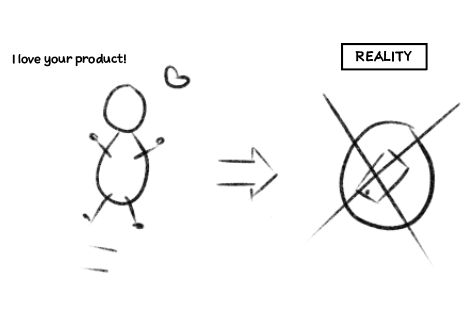Enriching UX with behavioural economics

One of the questions that I get about my interest in UX and my background in Behavioural Economics is one where people don’t understand the connection between these two. How do they relate?
The inability to take action is a very common bias in behavioural economics and I was also experiencing this about writing a story on this topic. This is an article that I wanted to write for a long time now and finally got the emotional appeal to do it after attending a webinar by Stephen Wendel on Designing for Behavioral Change.
Why is behavioural economics needed in UX?
Have you ever had this experience with users:

I assume you have, and you’re probably not the only one. It’s related to user behaviour.
User behaviour is complicated
Not because users are lying. No, it’s because your users are also humans. We should first understand the obstacles refraining people from taking action even though they have the intention, and then help them to overcome those obstacles.
“What they say they do and what they do are completely different” — Margaret Mead
That’s why, within UX Research we use contextual inquiries and ethnographic research. A complement to that is the use of behavioural economics to understand the mind of the users and design the right interventions to close the intention-action gap. This gap is explained by heuristics and biases. How many times have you postponed living a healthy lifestyle or learning a new language due to present bias? How many times have you started using a product because of herding?
Context shapes behaviour, and when we design, we try to design the environment. This can be the social, mental or physical environment to close the intention-action gap. We should aim to design products that change user behaviour, to help users do something they want to do but somehow struggle with. Obviously, without falling back into dark patterns. Behavioural Economics helps to transform people’s lives for the better, not to trick them to use your product for company objectives.
How can we enrich our existing product development process with behavioural economics?
For product development it is foremost important to understand how people make decisions, what obstacles they are facing and then designing the right intervention to change behaviour. The following steps can be added to the existing product development process:
1. Add a behavioural map to the journey map. A behavioural map contains tiny actions, micro behaviour that a person has to take from the current state of inaction to the ideal state of action.
2. You can analyse each micro behaviour that contains problems with the CREATE framework and make your behavioural diagnosis to use in designing your intervention.

The CREATE framework contains 6 mental processes that enable users to make conscious decisions about using your product. These are important to consider when designing your product, as these might become behavioural obstacles.
3. Use DECIDE framework to go a step further and design interventions.
Define the problem, audience and outcome
Explore the context and reimagine the action
Craft the intervention
Implement the solution
Determine impact by testing multiple interventions
Evaluate next steps (involving iterations)
For more detailed information about CREATE and DECIDE frameworks, check Wendel’s book and *free workbook* on designing behavioural change

